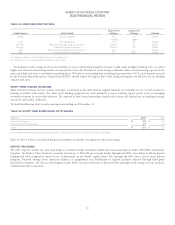American Express 2014 Annual Report Download - page 46
Download and view the complete annual report
Please find page 46 of the 2014 American Express annual report below. You can navigate through the pages in the report by either clicking on the pages listed below, or by using the keyword search tool below to find specific information within the annual report.
AMERICAN EXPRESS COMPANY
2014 FINANCIAL REVIEW
LIQUIDITY MANAGEMENT
Our liquidity objective is to maintain access to a diverse set of on- and off-balance sheet liquidity sources. We maintain liquidity sources in
amounts sufficient to meet business requirements and expected future financial obligations for a period of at least twelve months in the event
we are unable to raise new funds under our regular funding programs during a substantial weakening in economic conditions. We have in
place a liquidity risk policy that sets out our approach to managing liquidity risk on an enterprise-wide basis.
We incur and accept liquidity risk arising in the normal course of offering our products and services. The liquidity risks that we are
exposed to can arise from a variety of sources, and thus our liquidity management strategy includes a variety of parameters, assessments and
guidelines, including, but not limited to:
폷Maintaining a diversified set of funding sources (refer to Funding Strategy section for more details);
폷Maintaining unencumbered liquid assets and off-balance sheet liquidity sources available to meet obligations;
폷Projecting cash inflows and outflows from a variety of sources and under a variety of scenarios; and
폷Incorporating into the Internal Capital Adequacy Assessment Process trade-offs between the risk of insufficient liquidity and our
profitability.
We seek to maintain access to a diverse set of liquidity sources, including cash and other liquid assets on-balance sheet as well as off-
balance sheet financing sources such as committed bank facilities and ABS conduit facilities, in order to comply with requirements of the
Dodd-Frank Act and other regulatory measures of liquidity such as the Liquidity Coverage Ratio (LCR). We, through our U.S. bank
subsidiaries, also hold collateral eligible for use at the Federal Reserve’s discount window.
We seek to satisfy the requirements of a variety of stress scenarios, including those required by law and regulation as well as our own
stress scenario, in order to determine the amount and mix of the liquidity sources we maintain at any given time. These stress scenarios
possess distinct characteristics and vary by cash flow assumptions, time horizon and qualifying liquidity sources, among other factors. Our
own stress scenario assumes we are unable to access our regular funding programs during a severe macroeconomic scenario, in which case
we would target a mix of on- and off-balance sheet liquidity sources to satisfy financial obligations, such as debt maturities, and the projected
net cash flows needs of our businesses for a period of at least twelve months. The LCR is another form of stress scenario that prescribes
distinct cash flow assumptions over a 30-day period, and establishes criteria for qualifying on balance sheet assets as High-Quality Liquid
Assets.
We consider various factors in determining the amount of liquidity we maintain, such as economic and financial market conditions,
seasonality in business operations, growth in our businesses, potential acquisitions or dispositions, the cost and availability of alternative
liquidity sources, and regulatory and credit rating agency considerations.
The yield we receive on our cash and readily marketable securities is, generally, less than the interest expense on the sources of funding
for these balances. Thus, we incur substantial net interest costs on these amounts. The level of net interest costs will be dependent on the size
of our cash and readily marketable securities holdings, as well as the difference between our cost of funding these amounts and their
investment yields.
Securitized Borrowing Capacity
As of December 31, 2014, we maintained our committed, revolving, secured borrowing facility, with a maturity date of July 15, 2016, that
gives us the right to sell up to $3.0 billion face amount of eligible AAA notes from the American Express Issuance Trust II (the Charge Trust).
We also maintained our committed, revolving, secured borrowing facility, with a maturity date of September 15, 2017, that gives us the right
to sell up to $2.0 billion face amount of eligible AAA certificates from the Lending Trust. Both facilities are used in the ordinary course of
business to fund seasonal working capital needs, as well as to further enhance our contingent funding resources. As of December 31, 2014,
$2.5 billion was drawn on the Charge Trust facility, which was repaid on February 17, 2015, and no amounts were drawn on the Lending
Trust facility.
Federal Reserve Discount Window
As insured depository institutions, the Banks may borrow from the Federal Reserve Bank of San Francisco, subject to the amount of
qualifying collateral that they may pledge. The Federal Reserve has indicated that both credit and charge card receivables are a form of
qualifying collateral for secured borrowings made through the discount window. Whether specific assets will be considered qualifying
collateral and the amount that may be borrowed against the collateral remain at the discretion of the Federal Reserve.
46
























